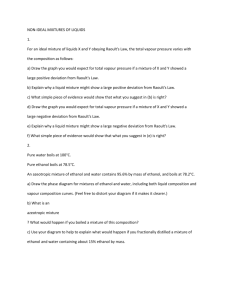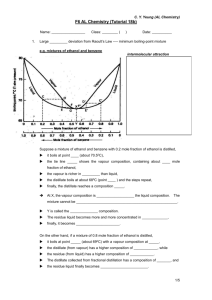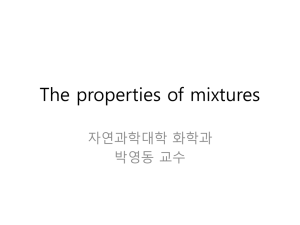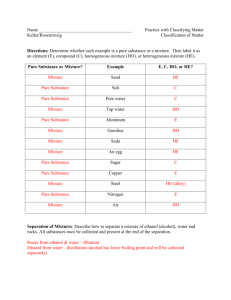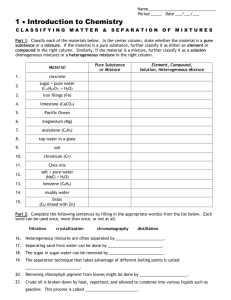ethanol bp
advertisement
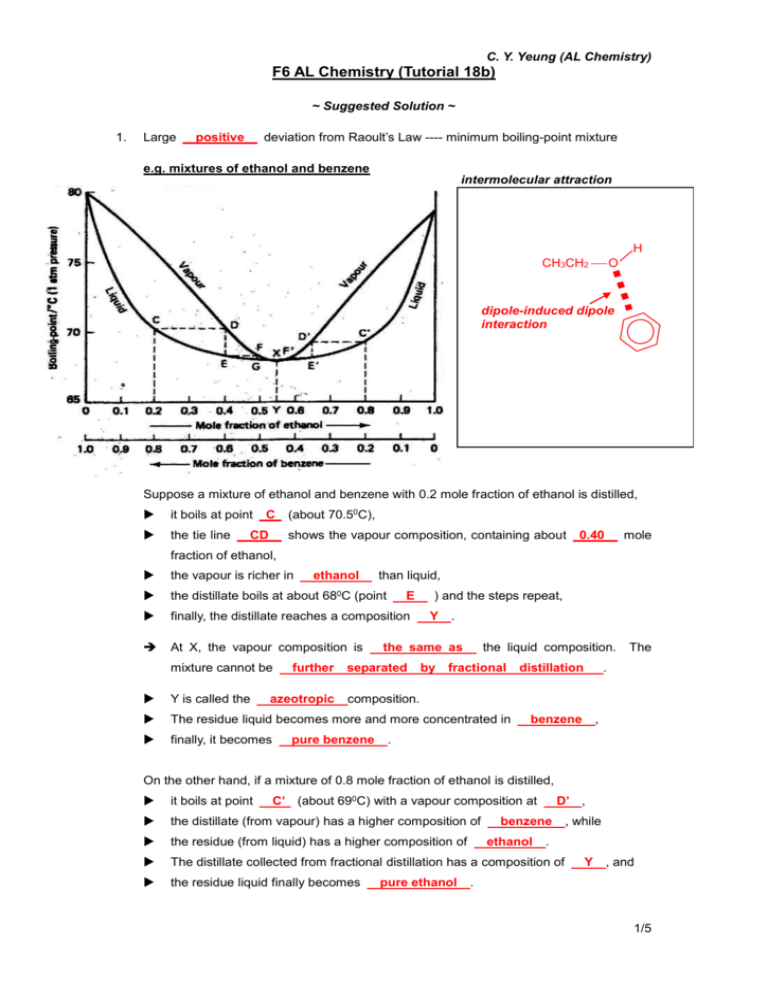
C. Y. Yeung (AL Chemistry) F6 AL Chemistry (Tutorial 18b) ~ Suggested Solution ~ 1. Large deviation from Raoult’s Law ---- minimum boiling-point mixture positive e.g. mixtures of ethanol and benzene intermolecular attraction H CH3CH2 O dipole-induced dipole interaction Suppose a mixture of ethanol and benzene with 0.2 mole fraction of ethanol is distilled, it boils at point the tie line C CD (about 70.50C), shows the vapour composition, containing about 0.40 mole fraction of ethanol, the vapour is richer in the distillate boils at about 680C (point finally, the distillate reaches a composition At X, the vapour composition is mixture cannot be ethanol further than liquid, E ) and the steps repeat, Y . the same as separated the liquid composition. by fractional Y is called the The residue liquid becomes more and more concentrated in finally, it becomes azeotropic distillation The . composition. pure benzene benzene , . On the other hand, if a mixture of 0.8 mole fraction of ethanol is distilled, it boils at point the distillate (from vapour) has a higher composition of the residue (from liquid) has a higher composition of The distillate collected from fractional distillation has a composition of the residue liquid finally becomes C’ (about 690C) with a vapour composition at pure ethanol D’ , benzene ethanol , while . Y , and . 1/5 2. Large negative C. Y. Yeung (AL Chemistry) deviation from Raoult’s Law ---- maximum boiling-point mixture e.g. mixtures of propanone and trichloromethane intermolecular attraction CH3 H3C C O hydrogen bond H Cl C Cl Cl Suppose a mixture of 0.3 mole fraction of trichloromethane is distilled, it boils at point the vapour has a composition of D such that the mole fraction of C (about 60.80C), propanone is higher. When the vapour D When it boils again, the vapour has a higher composition of condenses to E, the distillate has a lower boiling point. propanone and the fractional distillation goes on. Therefore, if liquid mixture with composition C is fractional distilled, the distillate collected would be pure propanone . But if liquid mixture with composition C’ is fractional distilled, the distillate collected would be pure trichloromethane . ########################################################################## To conclude, in both cases (positive and negative deviations from Raoult’s Law), 1. 2. ONLY one component can be separated from the For the azeotropic composition, the vapour composition is mixture the same . as its liquid composition. 2/5 C. Y. Yeung (AL Chemistry) 3. Behaviour of different liquid mixture when subjected to Fractional Distillation Ideal solutions intermolecular A-A, B-B and A-B interactions forces are similar Positive deviation from the Negative deviation from the Raoult’s Law Raoult’s Law average A-A, B-B interaction average A-A, B-B interaction is stronger is weaker than A-B interaction than A-B interaction heat change after mixing No change Absorbs heat (endothermic) Releases heat (exothermic) volume change after mixing No change Increases Decreases vapour pressure expected by Raoult’s Law higher than expected than expected b.p. b.p. b.p. lower vapour vapour diagram of boiling point of mixture vapour liquid liquid liquid L1 0 mole fraction of A 1 no relative max. or min. azeotrope no simple distillate : pure A distillation 0 mole fraction of A 1 relative minimum exists L2 0 mole fraction of A 1 relative maximum exists at the liquid composition of at the liquid composition of min. b.p. (a) max. b.p. (a) cannot separated the two components completely distillation fractional L1 L2 residue: distillate: azeotropic mixture distillate: start at L1, pure B start at L2, pure A pure B residue: start at L1, pure B start at L2, pure A residue: azeotropic mixture 3/5 4. C. Y. Yeung (AL Chemistry) At 1 atmospheric pressure, nitric acid (b.p. = 860C) and water (b.p. = 1000C) form an azeotropic mixture with boiling point 1210C. The mole fraction of nitric acid in the azeotropic mixture is 0.46. (a) Sketch the boiling point-composition diagram of the mixture of nitric acid and water. Label both the liquid and vapour composition curves clearly. Since the b.p. of mixture is higher than that of pure liquids, negative deviation of Raoult’s Law was shown. b.p. 1210C 1000C vapour liquid 860C 0.46 0.75 1 0 mole fraction of HNO3 (b) If a nitric acid-water mixture containing 0.75 mole fraction of nitric acid is fractionally distilled, what are the compositions of the distillate and the residue liquid respectivelty? Distillate: Pure HNO3 Residue: Azeotropic mixture (0.46 HNO3, 0.54 H2O) (c) Explain why the nitric acid-water mixture shows a higher boiling point than both nitric acid and water. Due to the following equilibrium: H2O + HNO3 H3O+ + NO3- Strong electrostatic attraction is present between cation and anion, which is much stronger than the intermolecular forces between neutral molecules. 5. A mixture of miscible liquids A (b.p. = 400C) and B (b.p. = 600C) shows negative deviation with azeotropic composition at 0.4 mole fraction of A (b.p. = 800C). (a) Sketch the boiling point-composition curve of this system. b.p. 800C vapour 600C liquid 400C 1 0 0.20 0.40 0.70 mole fraction of A 4/5 C. Y. Yeung (AL Chemistry) (b) What will be obtained if a solution of 0.7 mole fraction of A is fractionally distilled? Distillate: Pure A Residue: Azeotropic mixture (0.40 A, 0.60 B) (c) What will be obtained if a solution of 0.2 mole fraction of A is fractionally distilled? 6. Distillate: Pure B Residue: Azeotropic mixture (0.40 A, 0.60 B) Ethanol (b.p. = 78.40C) and water (b.p. = 1000C) form an azeotrope with minimum in the boiling point. At 1 atm, the azeotrope contains 95.6% by mass of ethanol with a boiling point of 78.150C. When a mixture of 50% by mass of ethanol is fractionally distilled, only 95.6% by mass of ethanol can be obtained. (a) Calculate the mole fraction of ethanol in the azeotrope. mass ratio of H2O : CH3CH2OH = 4.40% : 95.6% molar ratio of H2O : CH3CH2OH = 4.40 95.6 : 2 16 2(12) 5 16 1 = Therefore, mole fraction of ethanol = 0.244 : 2.078 2.078 = 0.895 2.078 0.244 (b) Sketch a boiling point-mole fraction diagram, explain why pure ethanol can not be obtained from the mixture mentioned by fractional distillation. In the mixture of 50% by mass of ethanol, mole fraction of ethanol = 0.280 b.p. Upon boiling, the mixture gives a vapour containing more ethanol than 1000C liquid. vapour 78.40C liquid 0 0.280 0.895 1 mole fraction of ethanol 78.150C Repeated distillation increases the mole fraction of ethanol in vapour and finally gives pure water as residue. When the mole fraction of ethanol in distillate reaches composition, the the mixture azeotropic boils at 78.150C and the distillate contains 95.6% by mass of ethanol. 5/5
